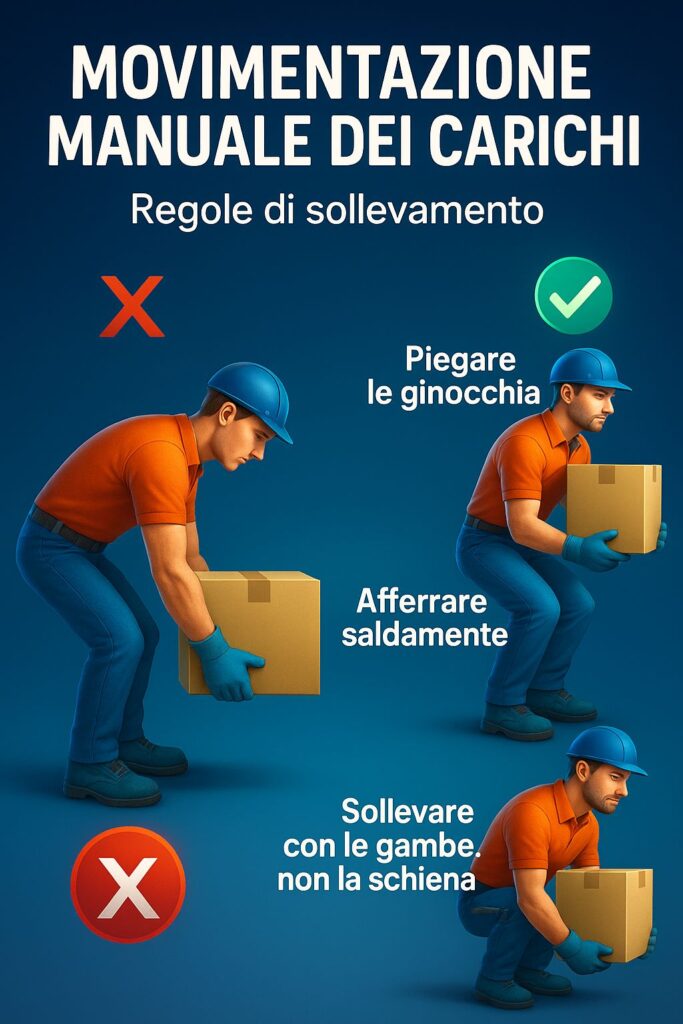Manual Handling of Loads: risks, obligations and prevention
Manual handling of loads is one of the most common activities in the workplace, but also a major cause of injuries and musculoskeletal disorders. It is often underestimated, but lifting, carrying, pushing or dragging a load incorrectly can have serious consequences, both short- and long-term.
In this article we will analyze:
- What is meant by manual handling of loads,
- What are the main risks,
- What the Italian regulations say,
- and especially how to prevent them with proper assessment and training.
What is manual handling of loads?
Legislative Decree 81/08, Article 167, defines manual handling of loads as any operation of carrying or supporting a load by one or more workers, including the actions of lifting, laying, pushing, pulling, carrying or moving a load.
So it is not just lifting boxes: moving a cart, dragging a pallet or holding a heavy tool for an extended time also fall into this category.
The main health risks
Manual handling activities involve biomechanical, postural and traumatic risks. The most common include:
- Musculoskeletal disorders (MSDs): pain and injury in the spine, especially in the lower back, but also in the shoulders, arms, and knees.
- Disc hernias: caused by excessive strain or improper posture.
- Strains and muscle tears
- Falling objects during handling, which can cause bruises or fractures.
The risk increases in the presence of:
- heavy or bulky loads
- repetitive or prolonged movements
- Inadequate work environment (slippery floors, tight spaces, poor lighting)
What the law provides for
Legislative Decree 81/08 devotes Title VI to the manual handling of loads. Employers are obliged to:
- Assess the risk, taking into account weight, load characteristics, environmental conditions and individual worker factors.
- Take organizational measures to minimize the need for manual handling.
- Train workers in the use of proper lifting and handling techniques.
- Provide mechanical aids when possible (carts, pallet trucks, lifts).
In the case of particularly exposed workers (e.g., warehouse workers, porters, logistics workers), it is also essential to conduct periodic health surveillance.
How to assess risk
The risk assessment of manual handling of loads must consider:
- Load weight
- Frequency and duration of effort
- Lifting distances
- Forced postures
- Work organization
Among the most commonly used tools for analysis are standardized methods such as:
- NIOSH (for lifting)
- Snook & Ciriello (for pushing and pulling)
- OCRA (for repetitive movements)
Accurate assessment allows critical issues to be identified and targeted corrective measures to be taken.
Prevention: the key to reducing injuries
The most effective preventive actions include:
1. Worker training
Teaching proper lifting techniques:
- Bend your knees, not your back,
- Keep the load close to the body,
- Avoid twisting of the torso during lifting,
- Working with two people for heavy loads.
2. Work organization
- Divide loads into lighter parts.
- Alternate between light and heavy activities.
- Encourage regular breaks in repetitive work.
3. Mechanical aids
- Carts, pallet trucks, conveyor belts.
- Ergonomic lifts for fixed workstations.
- Equipment up to standard and maintained.
4. Adaptation of the workplace
- Smooth and non-slip floors.
- Adequate maneuvering space.
- Sufficient lighting.
Conclusions
Manual handling of loads is a risky activity that deserves attention and prevention. With proper assessment, proper training and the use of appropriate tools, injuries and muscle disorders can be dramatically reduced.
A company that protects the health of its workers is a safer, more efficient and responsible company.
Do you need support in risk assessment in your company?
Our company specializes in occupational safety consulting. Contact us for a personalized consultation or to arrange training courses for your staff.
